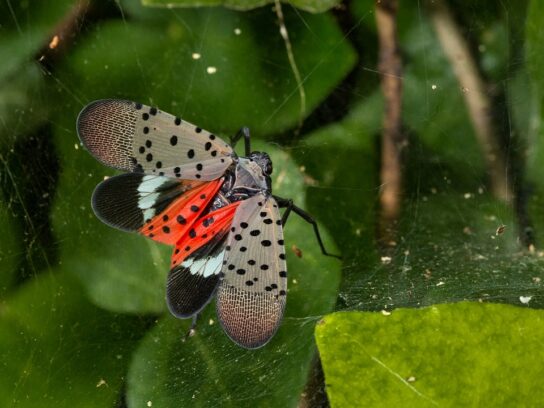
Invasive spotted lanternflies emerged in overwhelming numbers at the beginning of summer and now flourish across Montgomery County. The colorful Asian invader preys on crops and common plants.
Due to the threat they pose to agriculture, the Department of Agriculture imposed a quarantine on spotted lanternflies across 20 counties in Maryland, including Montgomery County, in 2024. Montgomery County is listed as “infested”, while neighboring counties including Howard County, Frederick County fall under “heavily infested”.
Invasive Characteristics
Spotted lanternflies nest along the trunks and stems of plants and suck phloem, the sugar-rich vascular tissue of plants, or sap. They do not bite or sting and are non-toxic to humans and animals.
Besides damaging crop yields by feeding on key agricultural crops, they also produce a sticky sugary fluid when feeding. This fluid can cause sooty mold, which further damages plants, according to the U.S. Department of Agriculture Animal and Plant Health Inspection Service.
As their numbers continue to climb, here are ways to combat the growing population of these invasive pests:
Homemade sprays
The University of Maryland Extension asks residents to avoid homemade sprays or insecticides. Here’s what they say: “Insecticide and other chemicals can harm non-target animals including pollinators and beneficial insects and will not effectively reach and kill all of the spotted lanternflies that are present and on the move. “
The Extension recommends physically killing the pests if you can reach them or to leave them for natural predators to feed on.
Mechanical control methods
Lanternfly nymphs and adults can be easily killed by stepping on them. The Department of Agriculture also recommends using nets and flyswatters, vacuums, and especially circle traps. Circle traps encapsulate the tops of trees, removing lanternfly access and funneling them into bags which can be disposed of. These traps take advantage of lanternflies’ poor flying abilities forcing them to move towards the tops of trees and bushes. Sticky tape or glue traps are not recommended due to their high rates of bycatch, indirectly effecting the ecosystem by threatening native insects alike.
Host plants
The primary host of the spotted lanternfly is Tree of Heaven, a similarly invasive species of tree. Spotted lanternflies also nest and feed on wild and cultivated grape, black walnut, red maple, silver maple, and weeping willow trees. Tree of Heaven is an aggressive invasive tree that entered the United States in the late 18th century. Its roots produce an allelopathic chemical that inhibits the growth of other plants around it. Tree of heaven grows rapidly and can be extremely hard to remove effectively.
The Maryland Department of Agriculture encourages anyone to record sightings of spotted lanternflies and report them here. That way scientists can monitor their population and spread. More information about how to combat lanternflies is located here.


Comments are closed.